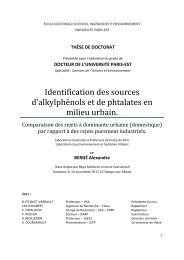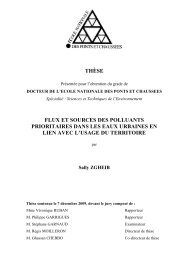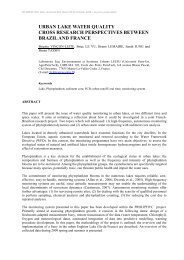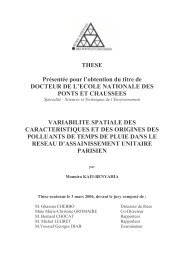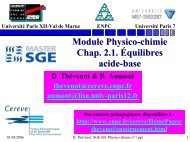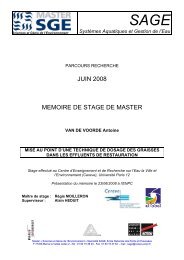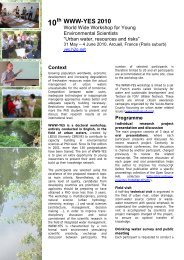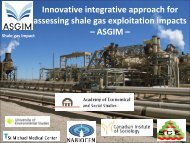Sources, transfert et devenir des alkylphénols et du bisphénol A dans le bassin amont de la Seine (Île-de-France)AbstractThis thesis focuses on occurrence and fate of seven alkylphenols and bisphenol A(BPA) on a basin divided into a heavily urbanized part and a second part which underscoreintense agricultural activities: the Seine River basin (Île-de-France Region). This study wasdivided into four different approaches.The first approach consists in studying the contamination of urban sources. To thisend, the effluents of the five biggest wastewater treatment plants (WWTP) of the IDF Region,combined sewer overflows (CSO), urban runoff and total atmospheric fallouts wereconsidered. This study highlight that BPA mainly occurs in wet-weather urban sources (CSOand urban runoff) while WWTP effluents are dominated by the nonylphenoxy acetic acid(NP 1 EC) which is a 4-nonylphenol (4-NP) precursor. The 4-NP was found in all investigatedurban sources at level close to a hundred of nanogram per liter (ng.l -1 ).The second approach focuses on the assessment of contamination of natural matricessuch as receiving surface water and soils at different scales. The first scale is the study of theOrgeval River basin which is representative of basins unpolluted by urban activities, while <strong>these</strong>cond scale accounts the entire IDF region including the Parisian Metropolitan area. Thesetwo scales revealed the large spread of 4-NP to all investigated natural matrices within theSeine River basin. At the scale of the IDF Region, the influence of the Parisian MetropolitanArea was demonstrated on NP 1 EC and BPA concentrations within the Seine River.On a third step, the biodegradability of nonylphenolic compounds was investigatedaccording to an innovative approach. The biodegradation rates were determined directlywithin the Seine River according to the ProSe model (Centre de Géoscience, école des MinesParisTech) and specific sampling campaigns performed on the Seine River. Thebiodegradation rates found during this study disclosed high variabilities according tobiological conditions of the Seine River. Actually, after an algal bloom, the biodegradationrates were found between 10 and 35 times higher than those established under commonbiological conditions.At last, the fluxes exported by the Seine River, at annually scale, were compared tothose emitted by all investigated urban sources. At the scale of year 2010, fluxes of 4-NP andBPA emitted by all investigated urban sources are not predominant compared with thoseexported by the Seine River at the outlet of the Parisian Metropolitan Area. This resultconfirms the large spread of 4-NP and BPA at the scale of the entire IDF Region likely due totheir important uses since the 1960’s. This result also raises some questions about the originsof such fluxes found in Seine River and about the contamination of the upstream part.This thesis was performed within the framework of the PIREN-Seine (ProgrammeInterdisciplinaire de Recherche sur l’ENvironnement de la Seine) and OPUR (Observatoiredes Polluants URbains) research programs.6
Liste des publications et communications1 PublicationsListe des publications et communications1.1 InternationalesCladière, M., Gasperi, J., Gilbert, S., Lorgeoux, C. et Tassin, B. (2010) "Alkylphenolethoxylates and bisphenol A in surface water within a heavily urbanized area, such asParis". Water Pollution X, n° 135, 131-142 pp.Gasperi, J., Zgheib, S., Cladière, M., Rocher, V., Moilleron, M. et Chebbo, G. (2011)"Priority pollutants in urban stormwater - Case of combined sewers". Water Research,special issue on urban stormwater, in press.Bergé, A., Cladière, M., Gasperi, J., Coursimault, A., Tassin, B. et Moilleron, R. (2012)"Meta-analysis of environmental contamination by alkylphenols". EnvironmentalScience and Pollution Research, n° 19 (9), 3798 - 3819 pp.Cladière, M., Gasperi, J., Lorgeoux, C., Bonhomme, C., Rocher, V. et Tassin, B. (2012)"Alkylphenolic compounds and bisphenol A contamination within a heavily urbanizedarea: case study of Paris". Environmental Science and Pollution Research, 1-11 pp,DOI : 10.1007/s11356-012-1220-6.1.2 NationalesCladière, M., Gasperi, J., Lorgeoux, C., Bonhomme, C., Rocher, V., Troupel, M. et Tassin, B.(2011) "Bisphénol A : Premiers résultats sur le bassin de la Seine". Techniques scienceet méthodes, n° 11, 43 - 52 pp.Gasperi, J., Cladière, M., Zgheib, S., Rocher, V., Moilleron, R. et Chebbo, G. (2012)"Substances prioritaires dans les rejets urbains de temps de pluie". Techniques scienceet méthodes, n°4, 30-43 pp.2 Communications internationales2.1 OralesCladière, M., Gasperi, J., Gilbert, S., Lorgeoux, C. et Tassin, B. (2010) "Alkylphenolethoxylates and bisphenol A in surface water within a heavily urbanized area, such asParis". Water Pollution X, Bucarest (Roumanie).Cladière, M., Gasperi, J., Lorgeoux, C. et Tassin, B. (2011) "Discharges of endocrinedisrupting chemicals by combined sewer overflows into receiving water: case-study ofthe Paris conurbation" World Wide Workshop for young environmentalist scientist,Arceuil (France).Gasperi, J., Cladière, M., Rocher, V. et Moilleron, R. (2011) "Combined sewer overflows andEU Water Framework Directive" SWITCH meeting, The Future of Urban Water:Solutions for Livable and Resilient Cities, Paris (France).2.2 Par affiches (posters)Cladière, M., Gasperi, J., Lorgeoux, C., Rocher, V. et Tassin, B. (2011) "Urban cycle ofalkylphenol and bisphenol A: case of Paris" ICCE, Zurich (Suisse).
- Page 3 and 4: RemerciementsRemerciementsL’exerc
- Page 5: RésuméRésuméCette thèse s’in
- Page 9 and 10: Liste des abréviationsNP 1 EC : Ac
- Page 11 and 12: Table des matièresChapitre II : Ma
- Page 13 and 14: Table des matières2 Publications s
- Page 15 and 16: Liste des figuresFigure III-19 : Va
- Page 17 and 18: Liste des tableauxTableau III-8 : C
- Page 19 and 20: Introduction généraleIntroduction
- Page 21 and 22: Introduction généraleLe bassin de
- Page 23 and 24: Introduction généralepluie (surve
- Page 25 and 26: Chapitre I : Contexte bibliographiq
- Page 27 and 28: Chapitre I : Contexte bibliographiq
- Page 29 and 30: Chapitre I : Contexte bibliographiq
- Page 31 and 32: Chapitre I : Contexte bibliographiq
- Page 33 and 34: Chapitre I : Contexte bibliographiq
- Page 35 and 36: Chapitre I : Contexte bibliographiq
- Page 37 and 38: Chapitre I : Contexte bibliographiq
- Page 39 and 40: Chapitre I : Contexte bibliographiq
- Page 41 and 42: Chapitre I : Contexte bibliographiq
- Page 43 and 44: Chapitre I : Contexte bibliographiq
- Page 45 and 46: Chapitre I : Contexte bibliographiq
- Page 47 and 48: Chapitre I : Contexte bibliographiq
- Page 49 and 50: Chapitre I : Contexte bibliographiq
- Page 51 and 52: Chapitre I : Contexte bibliographiq
- Page 53 and 54: Chapitre I : Contexte bibliographiq
- Page 55 and 56: Chapitre I : Contexte bibliographiq
- Page 57 and 58:
Chapitre I : Contexte bibliographiq
- Page 59 and 60:
Chapitre I : Contexte bibliographiq
- Page 61 and 62:
Chapitre I : Contexte bibliographiq
- Page 63 and 64:
Chapitre I : Contexte bibliographiq
- Page 65 and 66:
Chapitre I : Contexte bibliographiq
- Page 67 and 68:
Chapitre I : Contexte bibliographiq
- Page 69 and 70:
Chapitre I : Contexte bibliographiq
- Page 71 and 72:
Chapitre I : Contexte bibliographiq
- Page 73 and 74:
Chapitre I : Contexte bibliographiq
- Page 75 and 76:
Chapitre I : Contexte bibliographiq
- Page 77 and 78:
Chapitre II : Matériels et méthod
- Page 79 and 80:
Chapitre II : Matériels et méthod
- Page 81 and 82:
Chapitre II : Matériels et méthod
- Page 83 and 84:
Chapitre II : Matériels et méthod
- Page 85 and 86:
Chapitre II : Matériels et méthod
- Page 87 and 88:
Chapitre II : Matériels et méthod
- Page 89 and 90:
Chapitre II : Matériels et méthod
- Page 91 and 92:
Chapitre II : Matériels et méthod
- Page 93 and 94:
Chapitre II : Matériels et méthod
- Page 95 and 96:
Chapitre II : Matériels et méthod
- Page 97 and 98:
Chapitre II : Matériels et méthod
- Page 99 and 100:
Chapitre II : Matériels et méthod
- Page 101 and 102:
Chapitre II : Matériels et méthod
- Page 103 and 104:
Chapitre II : Matériels et méthod
- Page 105 and 106:
Chapitre II : Matériels et méthod
- Page 107 and 108:
Chapitre II : Matériels et méthod
- Page 109 and 110:
Chapitre III : Contamination du bas
- Page 111 and 112:
Chapitre III : Contamination du bas
- Page 113 and 114:
Chapitre III : Contamination du bas
- Page 115 and 116:
Chapitre III : Contamination du bas
- Page 117 and 118:
Chapitre III : Contamination du bas
- Page 119 and 120:
Chapitre III : Contamination du bas
- Page 121 and 122:
Chapitre III : Contamination du bas
- Page 123 and 124:
Chapitre III : Contamination du bas
- Page 125 and 126:
Chapitre III : Contamination du bas
- Page 127 and 128:
Chapitre III : Contamination du bas
- Page 129 and 130:
Chapitre III : Contamination du bas
- Page 131 and 132:
Chapitre III : Contamination du bas
- Page 133 and 134:
Chapitre III : Contamination du bas
- Page 135 and 136:
Chapitre III : Contamination du bas
- Page 137 and 138:
Chapitre III : Contamination du bas
- Page 139 and 140:
Chapitre III : Contamination du bas
- Page 141 and 142:
Chapitre III : Contamination du bas
- Page 143 and 144:
Chapitre III : Contamination du bas
- Page 145 and 146:
Chapitre III : Contamination du bas
- Page 147 and 148:
Chapitre III : Contamination du bas
- Page 149 and 150:
Chapitre III : Contamination du bas
- Page 151 and 152:
Chapitre III : Contamination du bas
- Page 153 and 154:
Chapitre III : Contamination du bas
- Page 155 and 156:
Chapitre IV : Modélisation du deve
- Page 157 and 158:
Chapitre IV : Modélisation du deve
- Page 159 and 160:
Chapitre IV : Modélisation du deve
- Page 161 and 162:
Chapitre IV : Modélisation du deve
- Page 163 and 164:
Chapitre IV : Modélisation du deve
- Page 165 and 166:
Chapitre IV : Modélisation du deve
- Page 167 and 168:
Chapitre IV : Modélisation du deve
- Page 169 and 170:
Chapitre IV : Modélisation du deve
- Page 171 and 172:
Chapitre IV : Modélisation du deve
- Page 173 and 174:
Chapitre IV : Modélisation du deve
- Page 175 and 176:
Chapitre IV : Modélisation du deve
- Page 177 and 178:
Chapitre IV : Modélisation du deve
- Page 179 and 180:
Chapitre IV : Modélisation du deve
- Page 181 and 182:
NP 1 EOTableau IV-8 : Indices de se
- Page 183 and 184:
Tableau IV-10 : Indices de sensibil
- Page 185 and 186:
Chapitre IV : Modélisation du deve
- Page 187 and 188:
Chapitre IV : Modélisation du deve
- Page 189 and 190:
Chapitre IV : Modélisation du deve
- Page 191 and 192:
Chapitre IV : Modélisation du deve
- Page 193 and 194:
Chapitre IV : Modélisation du deve
- Page 195 and 196:
Chapitre IV : Modélisation du deve
- Page 197 and 198:
Chapitre IV : Modélisation du deve
- Page 199 and 200:
Chapitre IV : Modélisation du deve
- Page 201 and 202:
Chapitre V : Evaluation des flux an
- Page 203 and 204:
Chapitre V : Evaluation des flux an
- Page 205 and 206:
Chapitre V : Evaluation des flux an
- Page 207 and 208:
Chapitre V : Evaluation des flux an
- Page 209 and 210:
Chapitre V : Evaluation des flux an
- Page 211 and 212:
Chapitre V : Evaluation des flux an
- Page 213 and 214:
Chapitre V : Evaluation des flux an
- Page 215 and 216:
Chapitre V : Evaluation des flux an
- Page 217 and 218:
Chapitre V : Evaluation des flux an
- Page 219 and 220:
Chapitre V : Evaluation des flux an
- Page 221 and 222:
Chapitre V : Evaluation des flux an
- Page 223 and 224:
Chapitre V : Evaluation des flux an
- Page 225 and 226:
Conclusions générales et perspect
- Page 227 and 228:
Conclusions générales et perspect
- Page 229 and 230:
Conclusions générales et perspect
- Page 231 and 232:
Références bibliographiquesRéfé
- Page 233 and 234:
Références bibliographiquesConsei
- Page 235 and 236:
Références bibliographiques2 Publ
- Page 237 and 238:
Références bibliographiquesevalua
- Page 239 and 240:
Références bibliographiquesEven,
- Page 241 and 242:
Références bibliographiquesGuardi
- Page 243 and 244:
Références bibliographiquesJugan,
- Page 245 and 246:
Références bibliographiquesLoyo-R
- Page 247 and 248:
Références bibliographiquesPeters
- Page 249 and 250:
Références bibliographiquesSpivac
- Page 251 and 252:
Références bibliographiquesZgheib
- Page 253 and 254:
AnnexesDébit (m 3 .s -1 )300250200


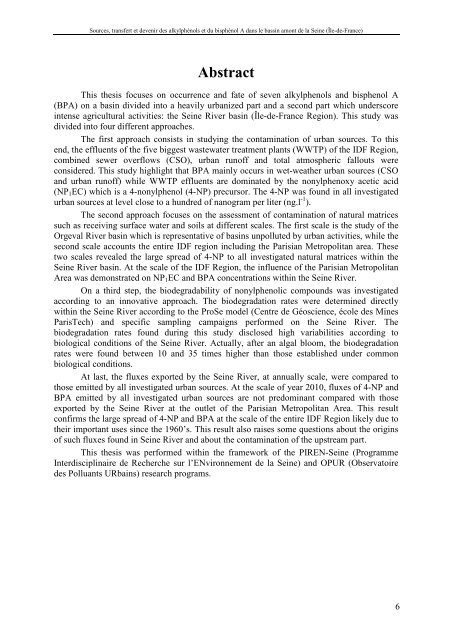

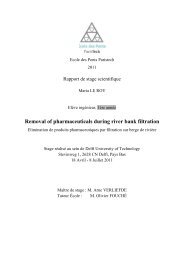
![[pastel-00730831, v1] Incidence des pratiques d'entretien ... - LEESU](https://img.yumpu.com/50938896/1/184x260/pastel-00730831-v1-incidence-des-pratiques-dentretien-leesu.jpg?quality=85)
